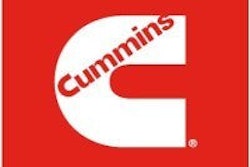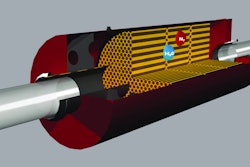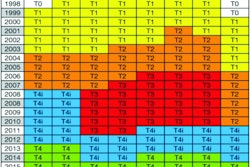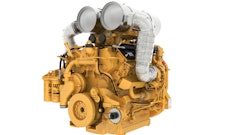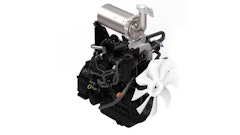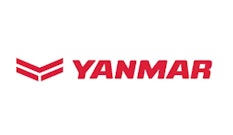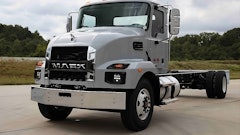Columbus, IN - Cummins Inc. announced today that the mechanical B3.3 engine will move forward to meet Tier 4 Final emissions standards in 2013 with a particulate filter aftertreatment system developed specifically for use in compact equipment rated below 75 hp (56 kW). The new exhaust aftertreatment operates as an independent system to achieve near-zero Particulate Matter (PM) emissions, enabling the B3.3 to simply "up tier" to Tier 4 Final without the need for any change to the engine.
Using a particulate filter-only solution for Tier 4 Final means that the B3.3 engine maintains exactly the same class-leading performance and reliability that it achieves today at Tier 4 Interim emissions levels. The inherent simplicity of the mechanically controlled 3.3-liter engine continues forward without adding engine electronics or changing the fuel system.
The ability of the B3.3 to easily up-tier with the particulate filter provides a more efficient installation solution by retaining the same engine configuration for use at all emissions levels worldwide across the important 55- to 74-hp (41-55 kW) power range for compact equipment.
The particulate filter has been developed by Cummins Emission Solutions to meet the EPA Tier 4 Final and equivalent emissions standards in Europe and Japan taking effect on Jan. 1, 2013, for engines below 75 hp (56 kW). The aftertreatment reduces PM emissions by over 90 percent to a near-zero level of 0.02 g/kW-hr for machines such as excavators, aerial lifts, forklifts, tractors, gensets, skid steer loaders and other compact equipment.
"Cummins up-tier solution for the B3.3 to meet Tier 4 Final is unique in the industry, with the new particulate filter replacing the exhaust muffler and with no change to the proven mechanical engine platform," said Chris Calas, Cummins 3.3-Liter Product Manager.
"With only one B3.3 engine configuration required for all markets worldwide, this means that equipment manufacturers will benefit from more streamlined production and easier in-service support. The machine cooling system remains the same for all emissions standards, with no additional heat rejection and no need for engine aftercooling.
"Our Tier 4 Final approach is intended to minimize equipment redesign and maintain our extremely reliable B3.3 with the benefit of mechanical simplicity. Customer demand for the 3.3-liter continues to grow significantly, and now we will move the capability of the B3.3 even further ahead of other similar 4-cylinder engines for Tier 4 Final," added Calas.
Cummins up-tier solution for the B3.3 is anticipated to realize higher residual equipment value for operators and rental fleets. Using the same engine as today for Tier 4 Final in 2013 also means that owners will continue to benefit from the outstanding dependability and low cost of maintenance, proven under the toughest duty cycles.
Independent Aftertreatment System
The B3.3 particulate filter achieves near-zero PM emissions by leveraging proven technology with the unrivaled experience of nearly 1 million Diesel Particulate Filters (DPFs) produced by Cummins Emission Solutions, a world leader in exhaust aftertreatment and components.
To maximize machine installation flexibility, the particulate filter is a self-contained package, with an oxidation catalyst and wall- flow filter ideally sized for compact-equipment applications below 75 hp (56 kW). The filter provides the same noise suppression as the muffler it replaces.
"The particulate filter for the B3.3 engine is designed as an independent aftertreatment system to reduce emissions with no impact on machine performance or operation," said Julie Furber, General Manager - Off-Highway Business Cummins Emission Solutions.
PM emissions are removed by a regeneration process that takes place passively for most of the equipment operating time. However, as a backup, the aftertreatment features an integral thermal management system that automatically initiates an active regeneration when required to clear the filter of PM buildup.
"A key performance attribute of the system is the aftertreatment control module, which applies Cummins electronic logic to precisely monitor engine exhaust conditions and control the thermal management active regeneration for the B3.3 mechanically controlled engine," added Furber.
Durability of the particulate filter is equivalent to that of the B3.3 engine, with very robust packaging intended for the harshest off- highway equipment operating conditions. The system features enhanced protection against vibration and shock loadings.
Naturally Aspirated And Turbocharged Ratings
For B3.3 Tier 4 Final applications with the particulate filter, the naturally aspirated 65-hp (48 kW) and 60-hp (45 kW) ratings are joined by a lower 55-hp (41 kW) rating to further extend the application range, providing a strong 158 lb-ft (214 N•m) of peak torque. The turbocharged B3.3 is rated 74 hp (55 kW), with an impressive peak torque of 178 lb-ft (241 N•m) and a torque rise of 22 percent.
For applications requiring less severe emissions standards than EPA Tier 4 Final and equivalent regulations in 2013, the same B3.3 ratings will remain available without the need for the particulate filter aftertreatment. The B3.3 mechanical ratings extend up to 85 hp (63 kW) for these lower emissions requirements.
The B3.3 can be specified with the advantage of single-side servicing and will also be available with the new Cummins Direct Flow(TM) air cleaner, offering extended filter change intervals and a smaller space claim than typical cylindrical cleaners.
A new production operation in Chennai, India, will complement B3.3 manufacturing in Japan, providing a major increase in build capacity to meet the continuing growth in demand from compact equipment manufacturers worldwide.




